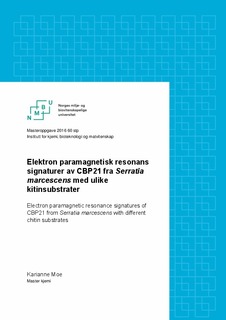| dc.contributor.advisor | Sørlie, Morten | |
| dc.contributor.author | Moe, Karianne | |
| dc.date.accessioned | 2016-08-10T07:37:13Z | |
| dc.date.available | 2016-08-10T07:37:13Z | |
| dc.date.issued | 2016-08-10 | |
| dc.identifier.uri | http://hdl.handle.net/11250/2398559 | |
| dc.description.abstract | Denne oppgaven er skrevet som en del av et større forskningsprosjekt der hovedmålet er å tilegne seg kunnskap om enzymer som katalyserer hydrolysere av glykosidbindinger i uløselige biopolymeren kitin. Kitin er den nest mest utbredte karbohydratet i naturen og består av β-(1,4)-linkede enheter av N-acetyl-D-glukosamin. Årlig blir det produsert over en milliard tonn kitin i biosfæren, hovedsakelig av insekter, sopp, skalldyr og andre marine organismer. Det kitinolytiske maskineriet til den gram-negative jordbakterien Serratia marcescens består av fire kitinaktive enzymer; kitinase A (ChiA), kitinase B (ChiB), kitinase C (ChiC) og karbohydrat bindingsmodul 21 (SmCBP21). I dette systemet degraderer kitinasene amorf kitin, mens SmCBP21 lager oksidative kjedebrudd i krystalline deler av polysakkaridet. Kjedebruddene gir en økt effekt av kitinasene i systemet. SmCBP21 er en kopper-avhengig lytisk polysakkarid monooksygenase som er avhengig av molekylært dioksygen og en ekstern elektrondonor for katalytisk aktivitet.
I denne oppgaven har elektron paramagnetisk resonans signaturer for SmCBP21-Cu2+ med ulike kitinsubstrater blitt undersøkt. Spektra av SmCBP21-Cu2+ med og uten kitinsubstrat viser signifikante forskjeller, sannsynligvis grunnet ulike konfigurasjoner av Cu2+ når enzymet danner interaksjoner med substrater. I studien viste alle krystallinske substrater liknende EPR-signaturer i kompleks med SmCBP21-Cu2+, mens spekteret for heksaacetylkitoheksaose viste små ulikheter.
Kitinsubstratene ble videre studert med Raman-spektroskopi. Spektra skilte mellom α- og β-kitin, men ikke fra deres respektive acetylerte derivater. Videre var det noen forskjeller i Raman-linje (sannsynligvis δ NH vibrasjon) assosiert med acetyleringsgrad i området rundt 1620 cm-1 av spektrumet.
I siste del av oppgaven ble tre eksterne elektrondonorer undersøkt ved potensiometri. Reduktantene viste forskjeller i deres elektrokjemiske egenskaper, hvor gallussyre var den svakeste reduktanten ved alle gitte betingelser. Eksperimentelle data viste at L-cystein var den sterkeste reduktanen ved høy pH, mens L-askorbat var den sterkeste under mildt syrlige forhold. Alle reduktantene hadde en sterkere reduseringsevne ved økt pH. L-cystein var reduktanten som ble minst påvirket av endringer i pH. En mulig forklaring er at de reduserende agentene har ulike reduksjons-mekanismer, hvor L-askorbat donerer et ulikt antall elektroner i forhold til L-cystein og gallussyre. | nb_NO |
| dc.description.abstract | This thesis is written as a part of a larger research project where the main goal is to acquire knowledge about enzymes that catalyzes the hydrolysis of the insoluble polymer chitin. Chitin is the second most abundant carbohydrate in nature and consist of β-(1,4)-linked units of N-acetyl-D-glucosamine. The annually production of chitin is over a billion ton in the biosphere, mainly by insects, fungi, crustaceans and other marine organisms. The chitinolytic machinery of the gram-negative soil bacterium Serratia marcescens consists of four chitin active enzymes; chitinase A (ChiA), chitinase B (ChiB), chitinase C (ChiC) and chitin binding protein 21 (SmCBP21). In this system the chitinases degrade amorphous chitin while SmCBP21 produces oxidative chain breaks in crystalline parts of the polysaccharide. The chain breaks gives a boosting effect of the chitinases in the system. SmCBP21 is a copper-containing lytic polysaccharide monooxygenase which are dependent on molecular dioxygen and an external electron donor for catalytic activity.
In this thesis, the electron paramagnetic resonance signatures of the binding of AA10 SmCBP21-Cu2+ to chitin substrates have been investigated. The spectra of SmCBP21-Cu2+ with and without chitin substrates show significant differences, probably because of different configurations of the Cu2+ when the enzyme interacts with the substrates. All the crystalline substrates show similar EPR signatures in complex with SmCBP21-Cu2+, whereas the spectra with the soluble hexaacetylchitohexaose show slightly different features.
The chitin substrates where also studied with Raman spectroscopy. The spectra of α- and β-chitin were distinguished from each other, but not from their respective modified acetylated derivatives. There were some differences in the Raman scattering associated with acetylation (probably δ NH vibration) in the 1620 cm-1 region of the spectrum.
In the last part of this thesis three external electron donors where investigated with potentiometry. They showed differences in their electrochemical properties where gallic acid were the weaker reducing agent in all the specified cases. Experimental data showed that L-cysteine was the strongest reducing agent with high pH-value, whereas L-ascorbate was the strongest under mild acidic conditions. All reducing agents showed stronger reducing power with higher pH values. Moreover the redox potential of L-cysteine wasn’t affected as much as the remaining reducing agents. A possible solution is that the reducing agents carry out different reducing mechanisms, where L-ascorbate donates a different number of electrons. | nb_NO |
| dc.language.iso | nob | nb_NO |
| dc.publisher | Norwegian University of Life Sciences, Ås | |
| dc.subject | Lytisk polysakkarid monooksygenaser | nb_NO |
| dc.subject | Elektron paramagnetisk resonans | nb_NO |
| dc.subject | SmCBP21 | nb_NO |
| dc.title | Elektron paramagnetisk resonans signaturer av CBP21 fra Serratia marcescens med ulike kitinsubstrater | nb_NO |
| dc.title.alternative | Electron paramagnetic resonance signatures of CBP21 from Serratia marcescens with different chitin substrates | nb_NO |
| dc.type | Master thesis | nb_NO |
| dc.subject.nsi | VDP::Mathematics and natural science: 400::Chemistry: 440::Physical chemistry: 443 | nb_NO |
| dc.subject.nsi | VDP::Mathematics and natural science: 400::Basic biosciences: 470::Biochemistry: 476 | nb_NO |
| dc.source.pagenumber | 83 | nb_NO |
| dc.description.localcode | M-KJEMI | nb_NO |
